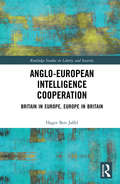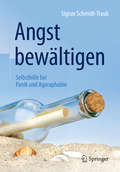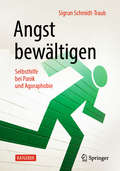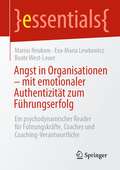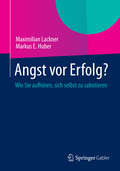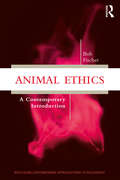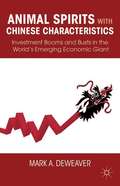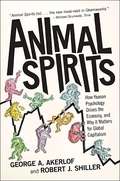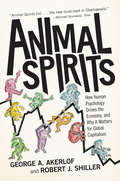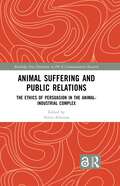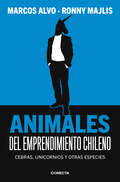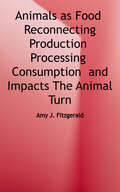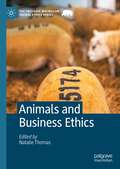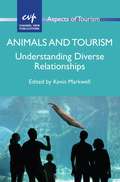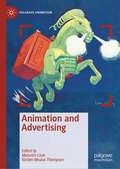- Table View
- List View
Anglo-American Life Insurance, 1800–1914 Volume 2
by Sharon Ann Murphy Timothy AlbornBy the eve of the Great Depression, there existed in America the equivalent of a policy for every man, woman and child, and in Britain it grew from its narrow aristocratic base to cover all social classes. This primary resource collection is the first comparative history of British and American life insurance industries.
Anglo-European Intelligence Cooperation: Britain in Europe, Europe in Britain (Routledge Studies in Liberty and Security)
by Hager Ben JaffelThis book investigates everyday practices of intelligence cooperation in anti-terrorism matters, with a specific focus on the relationship between Europe and Britain. The volume examines the effective involvement of British anti-terrorism efforts in European cooperation arrangements, which until now have been overshadowed by the UK-US ‘special relationship’ and by political debates that overstate the divide between Britain and continental Europe. In arguing that British intelligence has always had a European dimension, it provides a distinct perspective to the study of intelligence cooperation and the role of British intelligence therein. Mobilizing a ‘field theory’ approach, the book provides an original contribution to the understanding of intelligence cooperation by investigating everyday bureaucratic practices of ‘ground-level’ security professionals and police forces, embedded in a European ‘field’ structured around the exchange of anti-terror intelligence. It also accounts for the drivers behind cooperation by using ‘field analysis,’ which explains the trajectory and positioning of actors according to their ‘capitals’ rather than necessities dictated by threats or state decisions. This book will be of much interest to students of Security Studies, International Political Sociology, Intelligence Studies, and International Relations in general.
Angola and the Resource Curse
by Jonathan Schlefer Aldo Musacchio Eric WerkerSince emerging from decades of conflict in 2002, Angola has been growing at a scorching double-digit rate, led by its oil industry. But the nation remains beset with seemingly intractable problems: immense inequality, low life expectancy, a non-diversified economy, and constant grumblings of corruption. The global financial crisis and subsequent fall in state oil revenue drives a loan-seeking Angola towards either the IMF, who demand extensive reforms, or the Chinese, who seek to take a direct stake in the nation's recovery. The case explores the dynamics of post-conflict recovery as well as the challenges associated with a reliance on oil wealth, including the resource curse and Dutch disease.
Angst bewältigen: Selbsthilfe bei Panik und Agoraphobie
by Sigrun Schmidt-TraubDieser Ratgeber hilft Betroffenen, den Teufelskreis aus Angst und Vermeidung zu durchbrechen - er leitet zur Selbsthilfe an und gibt Tipps, an wen man sich wenden kann, wenn man sich Selbsthilfe nicht zutraut oder wenn man Unterst#65533;tzung in Selbsthilfegruppen sucht. Panikartige #65533;ngste sind enorm verbreitet. Die Angstzust#65533;nde sind verbunden mit meist heftigen k#65533;rperlichen Reaktionen wie Schwindel, Herzklopfen oder Schwei#65533;ausbr#65533;chen. Sie qu#65533;len und schr#65533;nken Betroffene zusehends ein. Angstpatientinnen und -patienten bringen im Laufe der Zeit immer mehr Situationen mit ihren Angstzust#65533;nden in Verbindung und vermeiden sie. Ein Teufelskreis, der sich aber mit Hilfe verhaltenstherapeutischen Wissens und Trainings aufl#65533;sen l#65533;sst. Der Ratgeber ist von einer erfahrenen Therapeutin verst#65533;ndlich und motivierend geschrieben. Fallbeispiele zeigen M#65533;glichkeiten auf, Panikattacken besser in den Griff zu bekommen. Gut strukturiert und #65533;bersichtlich - mit vielen Beispielen; wichtige Inhalte und Tipps sind hervorgehoben.
Angst bewältigen: Selbsthilfe bei Panik und Agoraphobie
by Sigrun Schmidt-TraubDieser Ratgeber hilft Betroffenen, den Teufelskreis aus Angst und Vermeidung zu durchbrechen – er leitet zur Selbsthilfe an und gibt Tipps, an wen man sich wenden kann, wenn man sich Selbsthilfe nicht zutraut oder wenn man Unterstützung in Selbsthilfegruppen sucht. Panikartige Ängste sind enorm verbreitet. Die Angstzustände sind verbunden mit meist heftigen körperlichen Reaktionen wie Schwindel, Herzklopfen oder Schweißausbrüchen. Sie quälen und schränken Betroffene zusehends ein. Angstpatientinnen und -patienten bringen im Laufe der Zeit immer mehr Situationen mit ihren Angstzuständen in Verbindung und vermeiden sie. Ein Teufelskreis, der sich aber mit Hilfe verhaltenstherapeutischen Wissens und Trainings auflösen lässt. Der Ratgeber ist von einer erfahrenen Therapeutin verständlich und motivierend geschrieben. Fallbeispiele zeigen Möglichkeiten auf, Panikattacken besser in den Griff zu bekommen. Gut strukturiert und übersichtlich – mit vielen Beispielen; wichtige Inhalte und Tipps sind hervorgehoben. Aus dem Inhalt: Zum Verständnis von Angst – Bewältigung der Angst – Materialien zur Selbsthilfe. Die Autorin:Dr. Sigrun Schmidt-Traub, Diplom-Psychologin und -Soziologin, Verhaltenstherapeutin für Kinder, Jugendliche und Erwachsene mit über 30-jähriger ambulanter Erfahrung in eigener Praxis. Heute in der Ausbildung von angehenden Verhaltenstherapeuten als Dozentin und Supervisorin tätig. Verfasserin von zahlreichen Selbsthilfe- und Lehrbüchern zum Thema Angststörungen.
Angst in Organisationen – mit emotionaler Authentizität zum Führungserfolg: Ein psychodynamischer Reader für Führungskräfte, Coaches und Coaching-Verantwortliche (essentials)
by Eva-Maria Lewkowicz Beate West-Leuer Marius NeukomUnliebsame Gefühle sind Merkmale konstruktiv authentischen Führens. Führungskräfte, die Angst erleben und reflektieren können, verfügen über Vorteile. Denn Angst ist nicht nur ein Schlüssel zur Ausbildung von Selbstkenntnis, sondern auch zur Förderung von Motivation, Zusammenarbeit und Veränderungsbereitschaft. In der Arbeitswelt wird Angst jedoch vermieden und tabuisiert, weil sie Abneigung erzeugt und als hemmend erlebt wird. Dieser Leitfaden macht dieses essenziell menschliche Gefühl zugänglich, erläutert seine unvermeidliche, gesunde wie auch krank machende Seite und zeigt Wege auf, wie es sinnvoll und produktiv in Führungsarbeit und Organisationsentwicklung integriert werden kann.
Angst vor Erfolg?: Wie Sie aufhören, sich selbst zu sabotieren
by Maximilian Lackner Markus E. HuberSie wünschen sich Erfolg - aber der will sich einfach nicht einstellen? Wenn Sie gerne erfolgreich wären, es aber Ihrer Meinung nach (noch) nicht sind, könnten Sie sich im Grunde davor fürchten und unbewusst Ihre eigenen Anstrengungen sabotieren. Immer wieder hält die meist unbewusste Furcht vor Veränderung Menschen davon ab, ihre ersehnten Ziele zu erreichen. Insbesondere die Angst vor dem Scheitern kann ihnen im Weg stehen. Dieses Buch hilft Ihnen, latente Ängste zu entlarven, sich ihnen zu stellen und sie zu überwinden. Sie erfahren, was Sie ganz konkret unternehmen können, um die angestrebten Ziele zu erreichen und wie Sie dabei Ihre eigene Erfolgsgeschichte schreiben. ". . . ein äußerst informativer und kompakt geschriebener Ratgeber, der einem hilft, die Steine des Misserfolgs, die in der eigenen Psyche oft genug den Weg versperren, beiseite zu räumen. " Mag. Adam Silye, Künstler "Sehr gründlich und gut recherchiert, ohne dabei belehrend zu wirken. Das Buch motiviert sehr, sich mit der Thematik auseinanderzusetzen und daraus für sich persönlich eine Lehre zu ziehen. " Katharina Kuhlmann, HR-Managerin
Angus Cartwright IV
by William J. Poorvu Howard H. Stevenson Arthur I Segel John H. Vogel Jr. Kenneth J. HattenJudy and John DeRight, looking to diversify their investment portfolios, have retained Angus Cartwright, Jr. to identify prospective real estate acquisitions. Mr. Cartwright has four potential properties that he feels merit an in-depth financial analysis. The case provides an opportunity to examine the various components of real estate return--cash flow, tax benefits, and futures--and measure the profitability of a proposed investment through the calculation of net present value, internal rate of return, and capitalization rate.
Angus Cartwright, III
by William J. Poorvu Howard H. Stevenson Arthur I Segel John H. Vogel Jr. Kenneth J. HattenJudy and John DeRight, looking to diversify their investment portfolios, have retained Angus Cartwright, Jr. to identify prospective real estate acquisitions. Mr. Cartwright has four potential properties that he feels merit an in-depth financial analysis. The case provides an opportunity to examine the various components of real estate return--cash flow, tax benefits, and futures--and measure the profitability of a proposed investment through the calculation of net present value, internal rate of return, and capitalization rate.
Anheuser-Busch and Campbell Taggart
by Erik Sirri Jonathan ShakesIn 1984, the SEC accused Paul Thayer and eight others of insider trading. Some of Thayer's inside information came from his position on the board of Anheuser-Busch, where he had learned about Busch's 1982 merger with Campbell Taggart before the merger was publicly announced. The case deals with Busch's reaction after learning about the SEC suit. In considering possible actions by Busch, students may explore the workings of capital markets and attempt to estimate the amount of financial damage done to Busch by the insider trading. Other issues involve ethics, the allocation of management resources on costly legal battles, and the differing objectives of board members and managers.
Anheuser-Busch and the U.S. Brewing Industry
by Anita M. McgahanPresents an analytical report on the company's competitive position and on the industry structure in 1991. Used to show how a company can generate value through steady, incremental investment over a long period in a business model tailored to the industry context. Also illustrates the challenges of market leadership.
Animal Ethics: A Contemporary Introduction (Routledge Contemporary Introductions to Philosophy)
by Bob FischerThere are many introductions to the animal ethics literature. There aren’t many introductions to the practice of doing animal ethics. Bob Fischer’s Animal Ethics: A Contemporary Introduction fills that gap, offering an accessible model of how animal ethics can be done today. The book takes up classic issues, such as the ethics of eating meat and experimenting on animals, but tackles them in an empirically informed and nuanced way. It also covers a range of relatively neglected issues in animal ethics, such as the possibility of insect sentience and the ethics of dealing with pests. Finally, the book doesn’t assess every current practice using standard ethical theories, but tries to evaluate some of them using the moral frameworks endorsed by those involved. So, for instance, there is a chapter on the way that animal care and use committees try to justify some of the educational uses of animals, and the chapter on zoos considers the way that international zoological societies justify compromising animal welfare. The book wraps up with a discussion of the future of animal ethics. Each chapter opens with a helpful initial overview of the chapter and ends with a list of suggested readings to help students go further on their own. Key Features Covers animal ethics from an empirically informed perspective, bringing philosophy into conversation with key issues in animal science, conservation biology, economics, ethology, and legal studies, among other fields Provides ample coverage of the most salient current topics, including, for example: Debates about which animals are sentient The suffering of wild animals Research ethics The boundaries of activism Avoids suggesting that animal ethics is simply the practice of applying the right general theory to a problem, instead allowing readers to first work out the specific costs and benefits of making ethical decisions Impresses upon the reader the need for her to work out for herself the best way forward with difficult ethical issues, suggesting that progress can indeed be made Includes summaries and recommended readings at the end of each chapter
Animal Spirits with Chinese Characteristics
by Mark A. DeweaverAnimal Spirits with Chinese Characteristics is the first detailed account of the investment booms and busts that drive China's business cycles. This exciting new volume looks first at the causes of these fluctuations, then examines the central government's countercyclical policy responses. DeWeaver shows that the volatility of Chinese investment is primarily the result of perverse incentives inherited from the command-economy era. Beijing's most effective countercyclical policies therefore still take the form of ad hoc administrative interventions. Contrary to popular belief, Beijing cannot 'fine tune' the economy. It also stands little chance of transitioning to a less volatile 'mode of growth. '
Animal Spirits: How Human Psychology Drives the Economy, and Why It Matters for Global Capitalism
by Robert J. Shiller George A. AkerlofThe global financial crisis has made it painfully clear that powerful psychological forces are imperiling the wealth of nations today. From blind faith in ever-rising housing prices to plummeting confidence in capital markets, "animal spirits" are driving financial events worldwide. In this book, acclaimed economists George Akerlof and Robert Shiller challenge the economic wisdom that got us into this mess, and put forward a bold new vision that will transform economics and restore prosperity. Akerlof and Shiller reassert the necessity of an active government role in economic policymaking by recovering the idea of animal spirits, a term John Maynard Keynes used to describe the gloom and despondence that led to the Great Depression and the changing psychology that accompanied recovery. Like Keynes, Akerlof and Shiller know that managing these animal spirits requires the steady hand of government--simply allowing markets to work won't do it. In rebuilding the case for a more robust, behaviorally informed Keynesianism, they detail the most pervasive effects of animal spirits in contemporary economic life--such as confidence, fear, bad faith, corruption, a concern for fairness, and the stories we tell ourselves about our economic fortunes--and show how Reaganomics, Thatcherism, and the rational expectations revolution failed to account for them. Animal Spirits offers a road map for reversing the financial misfortunes besetting us today. Read it and learn how leaders can channel animal spirits--the powerful forces of human psychology that are afoot in the world economy today. In a new preface, they describe why our economic troubles may linger for some time--unless we are prepared to take further, decisive action.
Animal Spirits: How Human Psychology Drives the Economy, and Why It Matters for Global Capitalism
by Robert J. Shiller George A. AkerlofThe global financial crisis has made it painfully clear that powerful psychological forces are imperiling the wealth of nations today. From blind faith in ever-rising housing prices to plummeting confidence in capital markets, "animal spirits" are driving financial events worldwide. In this book, acclaimed economists George Akerlof and Robert Shiller challenge the economic wisdom that got us into this mess, and put forward a bold new vision that will transform economics and restore prosperity. Akerlof and Shiller reassert the necessity of an active government role in economic policymaking by recovering the idea of animal spirits, a term John Maynard Keynes used to describe the gloom and despondence that led to the Great Depression and the changing psychology that accompanied recovery. Like Keynes, Akerlof and Shiller know that managing these animal spirits requires the steady hand of government--simply allowing markets to work won't do it. In rebuilding the case for a more robust, behaviorally informed Keynesianism, they detail the most pervasive effects of animal spirits in contemporary economic life--such as confidence, fear, bad faith, corruption, a concern for fairness, and the stories we tell ourselves about our economic fortunes--and show how Reaganomics, Thatcherism, and the rational expectations revolution failed to account for them. Animal Spirits offers a road map for reversing the financial misfortunes besetting us today. Read it and learn how leaders can channel animal spirits--the powerful forces of human psychology that are afoot in the world economy today. In a new preface, they describe why our economic troubles may linger for some time--unless we are prepared to take further, decisive action.
Animal Suffering and Public Relations: The Ethics of Persuasion in the Animal-Industrial Complex (Routledge New Directions in PR & Communication Research)
by Núria AlmironAnimal Suffering and Public Relations conducts an ethical assessment of public relations, mainly persuasive communication and lobbying, as deployed by some of the main businesses involved in the animal industrial complex – the industries participating in the systematic and institutionalized exploitation of animals. Society has been experiencing a growing ethical concern regarding humans’ (ab)use of other animals. This is a trend first promoted by the development of animal ethics – which claims any sentient being, because of sentience, deserves moral consideration – and more recently by other approaches from the social sciences, including critical animal studies. In this volume, we aim to start an entirely unaddressed discussion within the field of public relations: the need to problematize the ethics of persuasion when nonhuman animal suffering is involved, particularly the impact of persuasion and lobbying on compassion towards other animals in the cases of food, experimentation, entertainment and environment management. The books provides an interdisciplinary, theoretical discussion illustrated with international case studies from experts in strategic communication, public relations, lobbying and advocacy, animal ethics, philosophy of law, political philosophy and social psychology. This unique book merges the fields of critical public relations, animal ethics and critical animal studies and will be of direct appeal to a wide range of researchers, academics and doctoral students across related fields.
Animal Suffering and Public Relations: The Ethics of Persuasion in the Animal-Industrial Complex (Routledge New Directions in PR & Communication Research)
by Núria AlmironAnimal Suffering and Public Relations conducts an ethical assessment of public relations, mainly persuasive communication and lobbying, as deployed by some of the main businesses involved in the animal-industrial complex—the industries participating in the systematic and institutionalised exploitation of animals.Society has been experiencing a growing ethical concern regarding humans’ (ab)use of other animals. This is a trend first promoted by the development of animal ethics—which claims any sentient being, because of sentience, deserves moral consideration—and more recently by other approaches from the social sciences, including critical animal studies. In this volume, we aim to start an entirely unaddressed discussion within the field of public relations: The need to problematise the ethics of persuasion when nonhuman animal suffering is involved, particularly the impact of persuasion and lobbying on compassion towards other animals in the cases of food, experimentation, entertainment, and environmental management. This book provides an interdisciplinary, theoretical discussion illustrated with international case studies from experts in strategic communication, public relations, lobbying and advocacy, animal ethics, philosophy of law, political philosophy, and social psychology.This unique book merges the fields of critical public relations, animal ethics, and critical animal studies and will be of direct appeal to a wide range of researchers, academics, and doctoral students across related fields.The Open Access version of this book, available at http://www.taylorfrancis.com, has been made available under a Creative Commons Attribution-Non Commercial-No Derivatives (CC BY-NC-ND) 4.0 license.
Animales del emprendimiento chileno: Cebras, Unicornios y otras especies
by Marcos Alvo Ronny MajlisHistorias de los más exitosos emprendimientos chilenos del último tiempo, ocupando la taxonomía animal para agruparlos con mucho humor. Cebras, unicornios, camellos, gacelas, cigüeñas y leones. La fauna chilena del emprendimiento es tan amplia como diversa. Los unicornios, la especie de moda, se han convertido en verdaderas estrellas de rock: algunos de sus especímenes, como los fundadores de NotCo y Cornershop, cuyas empresas están avaluadas en más de mil millones de dólares, son retratados por los medios de comunicación como el mejor ejemplo del Chilean Dream. Pero este título no se encarga solo de los animales de moda, sino también de otras especies que han sacado partido de sus características; desde la resiliencia del camello a la agilidad de la gacela, demostrando que existen otros modelos de desarrollo. Los animales del emprendimiento chileno narra las historias de startups que uno ni siquiera pensaría que son chilenos como Crystal Lagoons, Japi Jane y Runway; como también de empresas emergentes con un profundo sentido social como Algramo y Karün. Crónicas llenas de detalles, que no dejan de lado las dificultades propias de emprender. Hay éxitos meteóricos y consolidaciones pausadas, crisis de estrés con pasantías por centros médicos e historias de arduo trabajo y cuestionamientos. ¿Qué motiva a los chilenos a crear una empresa emergente? ¿Qué tienen en común quienes lo hacen? ¿Qué tiene que ver un animal cornudo mitológico con una buena idea? Estas son algunas de las preguntas que se responden a través de las historias de quienes lideran hoy el ecosistema del emprendimiento local.
Animals As Food: (Re)connecting Production, Processing, Consumption, and Impacts
by Amy J. FitzgeraldEvery day, millions of people around the world sit down to a meal that includes meat. This book explores several questions as it examines the use of animals as food: How did the domestication and production of livestock animals emerge and why? How did current modes of raising and slaughtering animals for human consumption develop, and what are their consequences? What can be done to mitigate and even reverse the impacts of animal production? With insight into the historical, cultural, political, legal, and economic processes that shape our use of animals as food, Fitzgerald provides a holistic picture and explicates the connections in the supply chain that are obscured in the current mode of food production. Bridging the distance in animal agriculture between production, processing, consumption, and their associated impacts, this analysis envisions ways of redressing the negative effects of the use of animals as food. It details how consumption levels and practices have changed as the relationship between production, processing, and consumption has shifted. Due to the wide-ranging questions addressed in this book, the author draws on many fields of inquiry, including sociology, (critical) animal studies, history, economics, law, political science, anthropology, criminology, environmental science, geography, philosophy, and animal science.
Animals and Business Ethics (The Palgrave Macmillan Animal Ethics Series)
by Natalie ThomasThis book engages with some of the most pressing ethical issues that arise from the use of animals in various business practices, providing interdisciplinary approaches to improving the nonhuman and human lives in animal-related industries. The chapters in this volume provide conceptual, theoretical and practical analyses of these issues that will shape the future direction of business ethics to more fully refl ect the impacts and implications of animal-based businesses on society, its members, and nature. The authors in this volume engage with topics including animal suffering and emotions, the commodifi cation of animals, vegetarian and vegan businesses and diets, technological innovations such as gene editing and lab-cultured meat, as well as captivity, corporate disclosure of animal welfare policies, and the possibility of humane jobs as well as the consideration of animals as stakeholders.
Animals and Tourism
by Kevin MarkwellThis book critically examines the many ways in which tourism and animals intersect, whether as tourist attractions, wildlife conservation tools, as travel companions or as meat to be eaten. It aims to make a meaningful contribution to the growing body of knowledge concerning the relationships between animals, tourists and the tourism industry. The chapters are organised into three themes: ethics and welfare; conflict, contradiction and contestation; and shifting relationships. Theoretically informed and empirically rich, the chapters examine topics such as whale watching, animal performances, the objectification and commodification of animals and stakeholder conflict among a range of others. It is hoped that the book will help to highlight key research questions and stimulate other researchers and students to reflect critically on the place of animals within tourism spaces, experiences, practices and structures.
Animals and the Economy (The Palgrave Macmillan Animal Ethics Series)
by Steven McMullenThis book explores the economic institutions that determine the nature of animal lives as systematically exploited objects traded in a market economy. It examines human roles and choice in the system, including the economic logic of agriculture, experimentation, and animal ownership, and analyses the marginalization of ethical action in the economic system. Animals and the Economy demonstrates that individual consumers and farmers are often left with few truly animal-friendly choices. Ethical participants in the economy must either face down an array of institutional barriers, or exit mainstream markets entirely. This book argues that these issues are not necessary elements of a market system, and evaluates a number of policy changes that could improve the lives of animals in the context of a market economy.
Animals, Food, and Tourism (Routledge Research in the Ethics of Tourism Series)
by Carol KlineFood is routinely given attention in tourism research as a motivator of travel. Regardless of whether tourists travel with a primary motivation for experiencing local food, eating is required during their trip. This book encompasses an interdisciplinary discussion of animals as a source of food within the context of tourism. Themes include the raising, harvesting, and processing of farm animals for food; considerations in marketing animals as food; and the link between consuming animals and current environmental concerns. Ethical issues are addressed in social, economic, environmental, and political terms. The chapters are grounded in ethics-related theories and frameworks including critical theory, ecofeminism, gustatory ethics, environmental ethics, ethics within a political economy context, cultural relativism, market construction paradigm, ethical resistance, and the Global Sustainable Tourism Criteria. Several chapters explore contradicting and paradoxical ethical perspectives, whether those contradictions exist between government and private sector, between tourism and other industries, or whether they lie within ourselves. Like the authors in Tourism Experiences & Animal Consumption: Contested Values, Morality, & Ethics, the authors in this book wrestle with a range of issues such as animal sentience, the environmental consequences of animals as food, viewing animals solely as a extractive resource for human will, as well as the artificial cultural distortion of animals as food for tourism marketing purposes. This book will appeal to tourism academics and graduate students as a reference for their own research or as supplementary material for courses focused on ethics within tourism.
Animation and Advertising (Palgrave Animation)
by Kirsten Moana Thompson Malcolm CookThroughout its history, animation has been fundamentally shaped by its application to promotion and marketing, with animation playing a vital role in advertising history. In individual case study chapters this book addresses, among others, the role of promotion and advertising for anime, Disney, MTV, Lotte Reiniger, Pixar and George Pal, and highlights American, Indian, Japanese, and European examples. This collection reviews the history of famous animation studios and artists, and rediscovers overlooked ones. It situates animated advertising within the context of a diverse intermedial and multi-platform media environment, influenced by print, radio and digital practices, and expanding beyond cinema and television screens into the workplace, theme park, trade expo and urban environment. It reveals the part that animation has played in shaping our consumption of particular brands and commodities, and assesses the ways in which animated advertising has both changed and been changed by the technologies and media that supported it, including digital production and distribution in the present day. Challenging the traditional privileging of art or entertainment over commercial animation, Animation and Advertising establishes a new and rich field of research, and raises many new questions concerning particular animation and media histories, and our methods for researching them.

